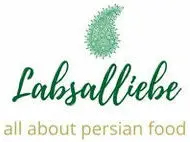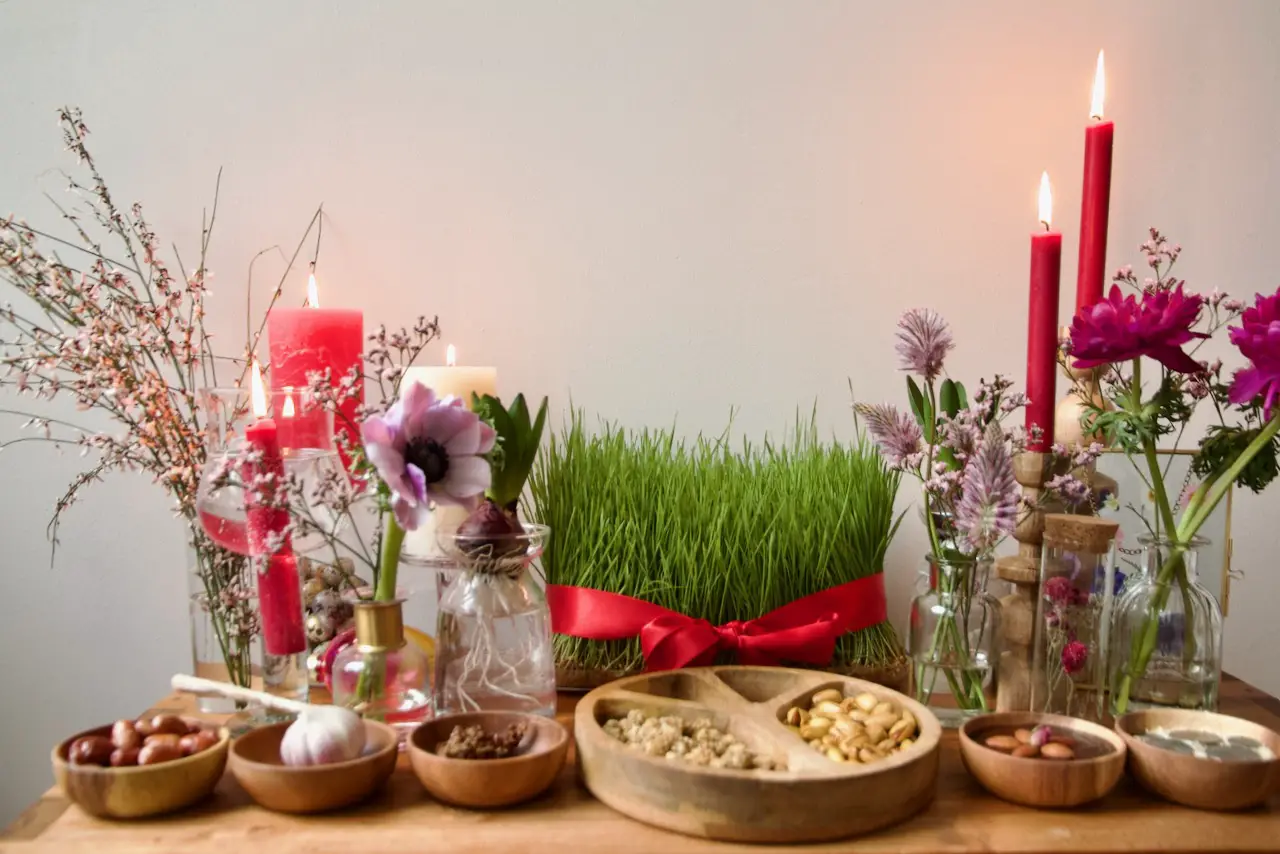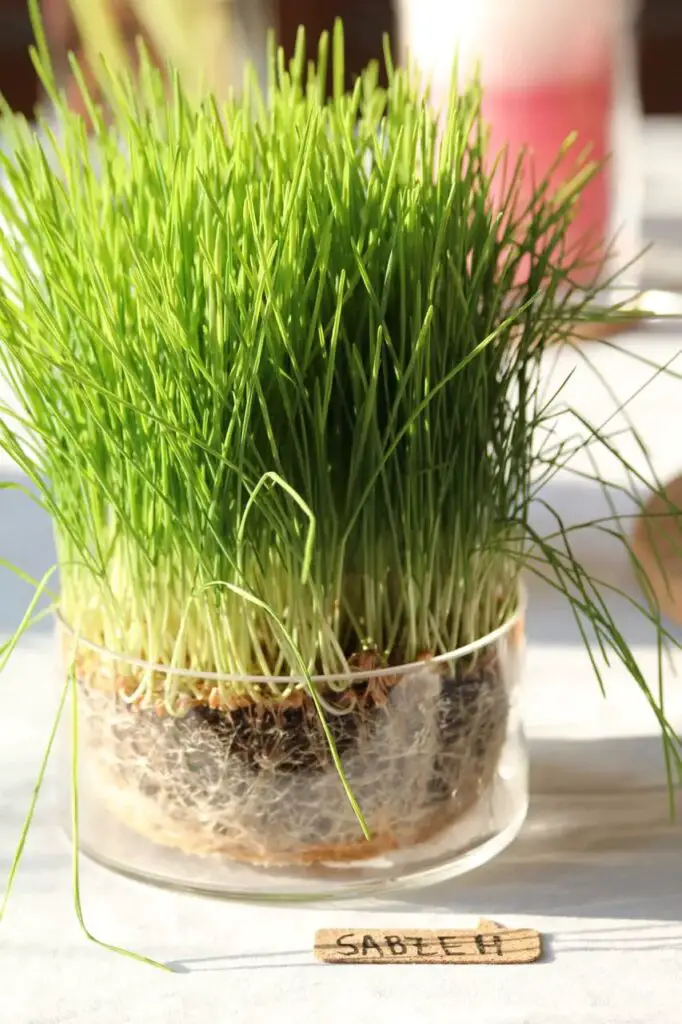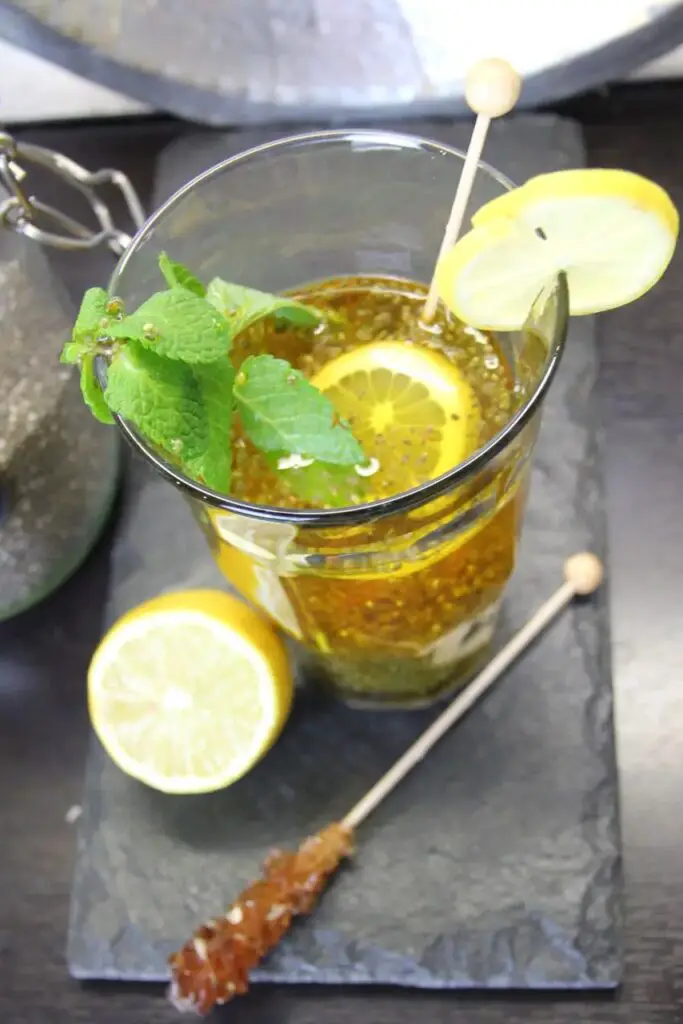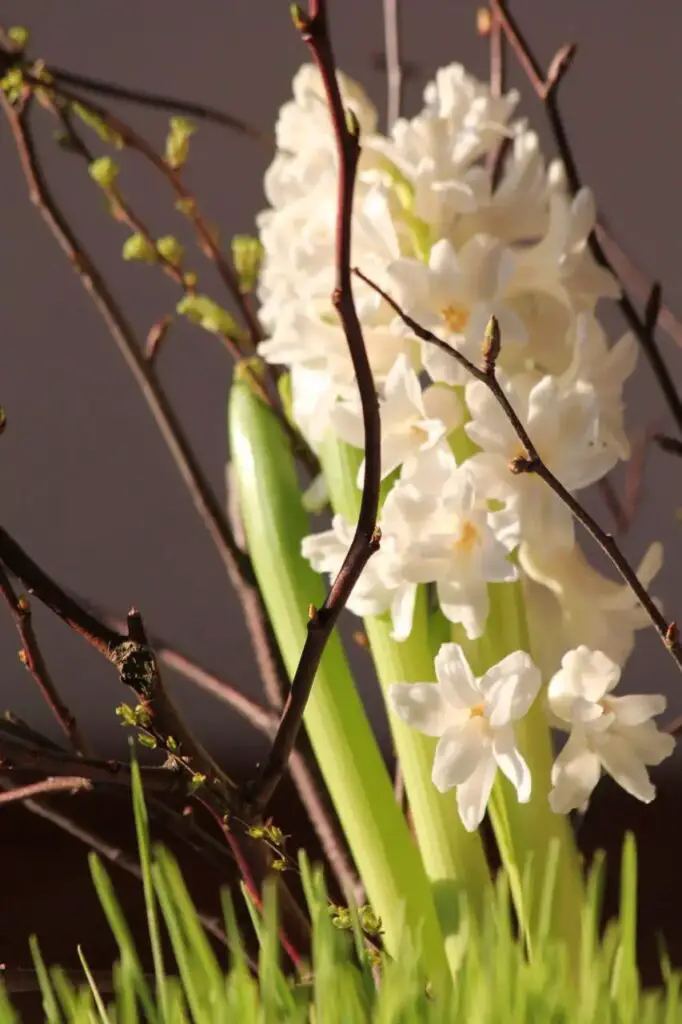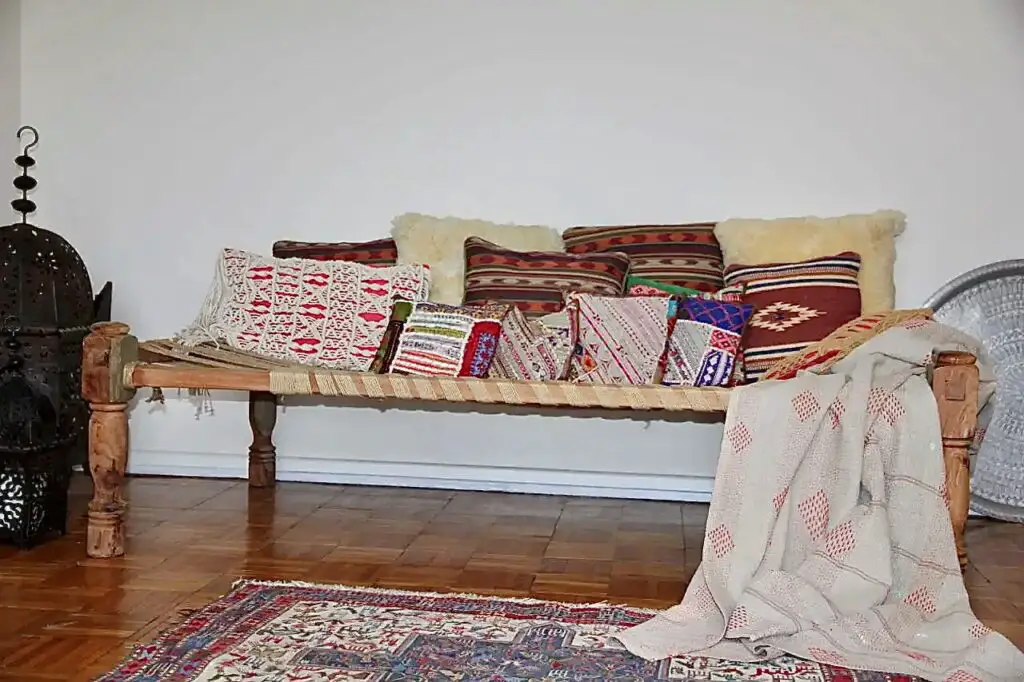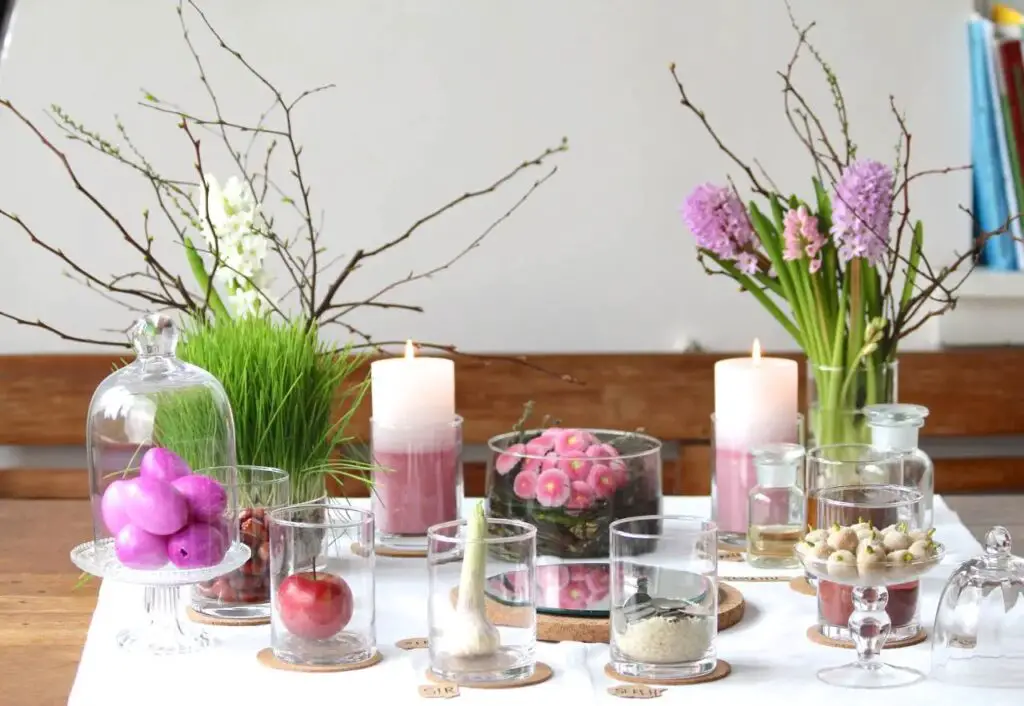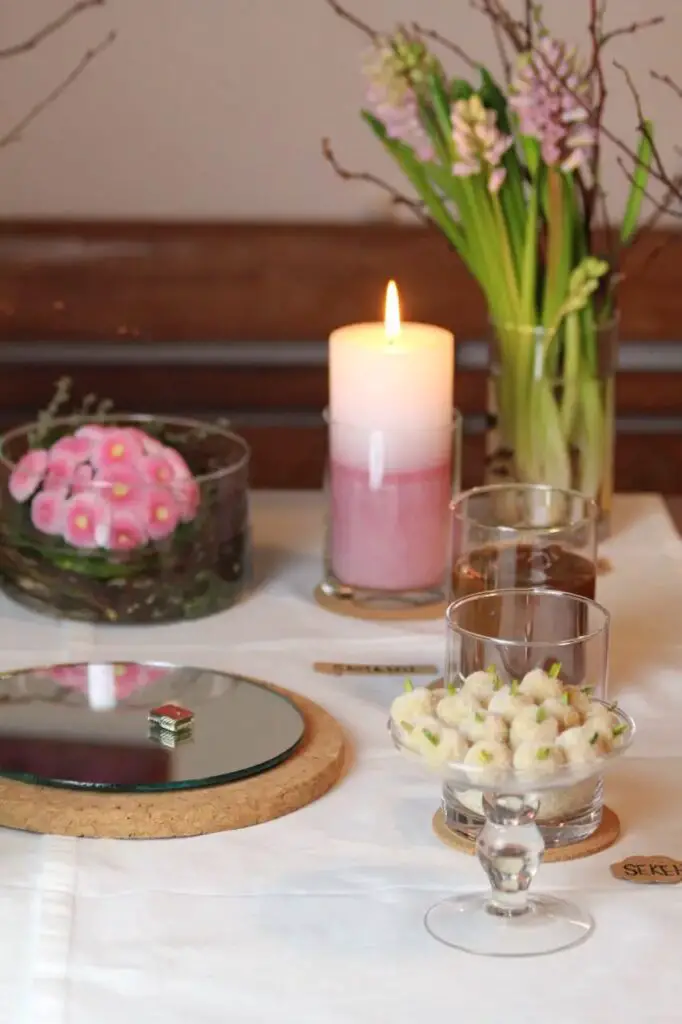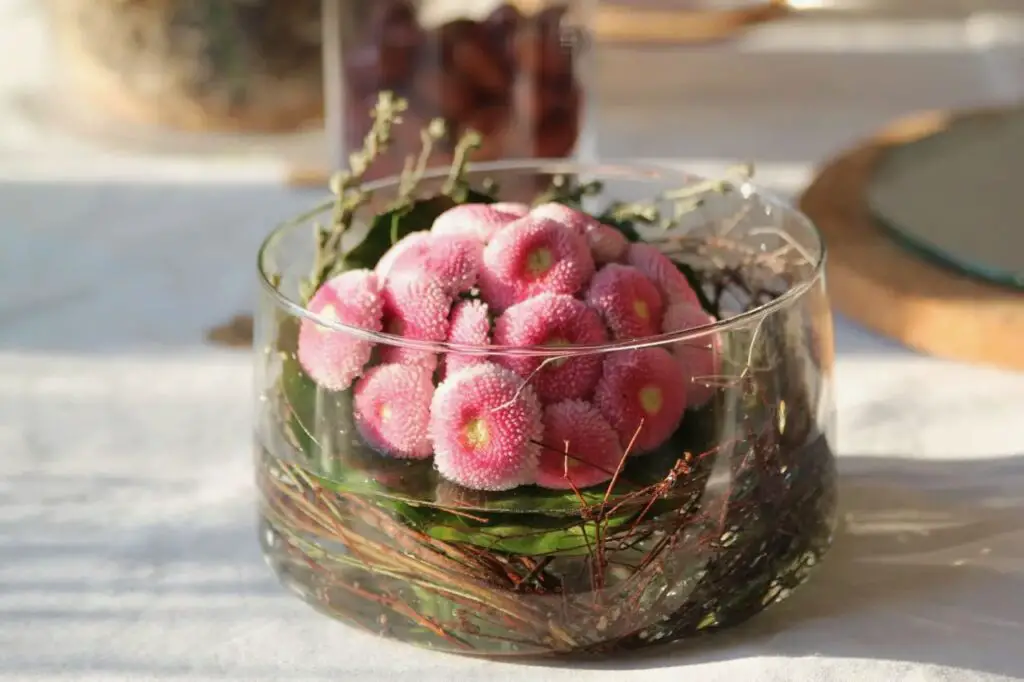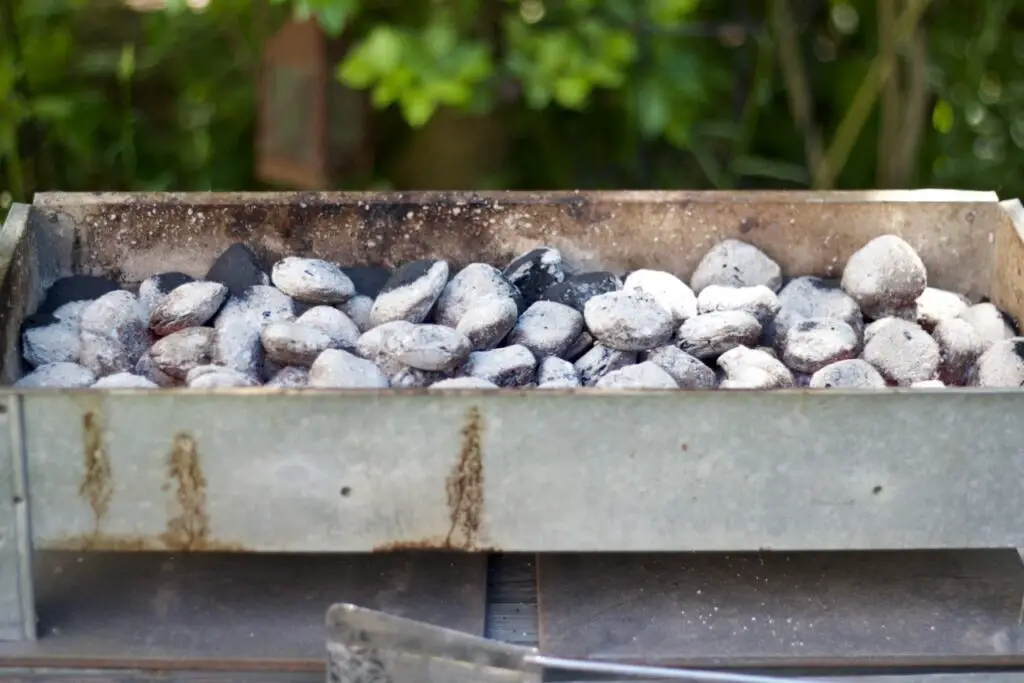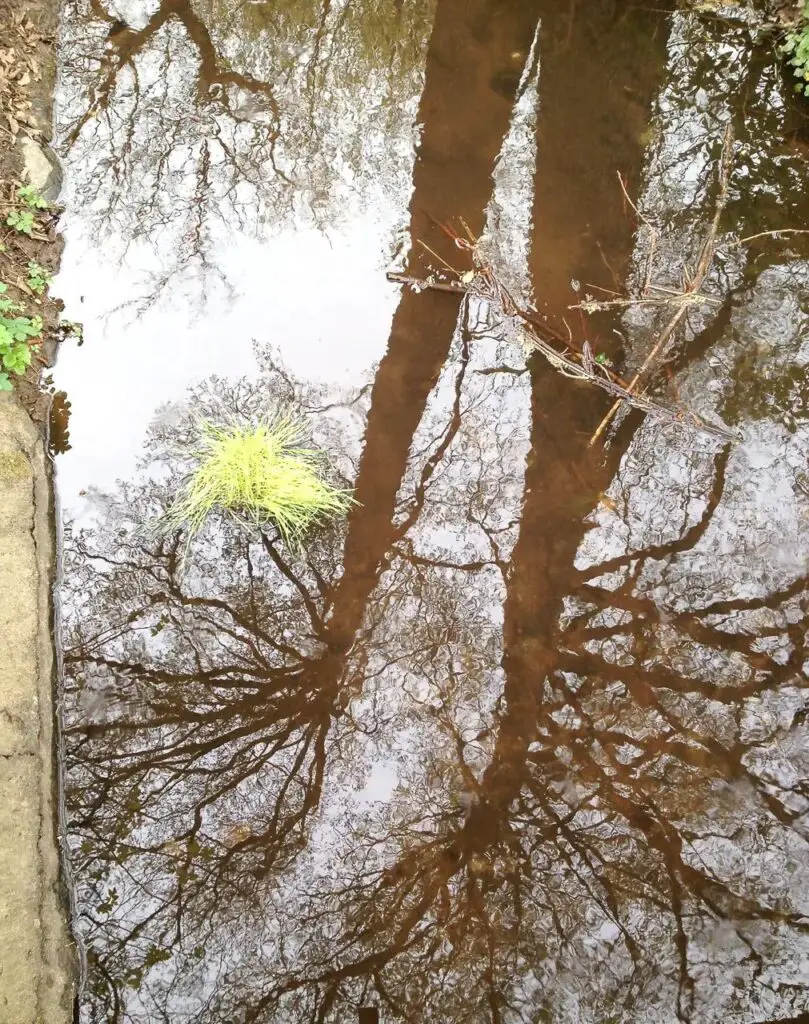Preparations for NOROOZ – The Celebration of Renewal نوروز starts about 2 weeks before with the sprouting of wheat, barley, or lentil seeds, which will turn into “sabzeh” in 2 weeks.
SABZEH FOR NOROOZ سبزه
Sabzeh is sprouted wheat, barley, or lentils and an item of Haft Sin, and it symbolizes vivacity and vitality. On Norooz, all the old is to be replaced by the new. My mom was busy cleaning the house. We were all dressed from head to toe in new outfits as we are supposed to start the New Year with new clothes. After Chaharshanbeh Suri – the Persian bonfire festival, we begin with the preparations for Norooz. We bought all the ingredients for Haft Sin at the Bazaar of Tehran. I enjoyed looking at goldfish in aquariums or plastic bowls and picking out the most beautiful fish for our Haft Sin. The smell of samanu and hyacinths infused the whole market. We enjoyed drinking the Sharbate Tokhme Sharbati – a Persian basil seed spring drink consisting of seven ingredients.
MEANING OF NOROOZ نوروز
The bakeries used to be full of the most delightful shirini (sweets), and my favorite Norooz sweet is still Nan Panjereeh – a Persian Rosette Pastry. You can find the recipe for these here. No means new, and Rooz the day – a new day. It is the oldest festival that exists. It’s celebrated since 2500 Years, and therefore the UNESCO added it to the list of human cultural heritage in 2010.
NOROOZ IS THE BEGINNING OF SPRING نوروز
The Persian New Year begins at Equinox. Worldwide the day and night are of equal length on this day. The earth has now rotated once around the sun, and spring begins. That’s why Norooz can either be on March 20 or 21. Not only the date of Norooz can vary, but also the time. One can calculate the beginning of spring down to the very second. This year the beginning of spring, and our new year is 20.03. at 22:24 in Germany. My father used to set up an old school clock for our Haft Sin every year. We would gather around the Haft Sin on New Year, and as soon as the clock started ringing, we knew the New Year was here. We celebrate Norooz for 13 days.
KHANEH TAKANIخانه تکانی
Khaneh Takani is the Persian spring cleaning – Khaneh means the house and Takani shake. So the home is shaken and rattled entirely before Norooz. Everyone’s home is clean, the walls of the houses repainted, the window frames wiped, and the carpets scrubbed clean. I remember when I was a kid, we carried all our Persian rugs into our yard and rinsed them off with water and soap. Then we used to sled barefoot on the carpets and had a lot of fun. We slithered until the carpets were shiny beneath our feet. The smell of water, soap, and wool is a childhood memory. The rugs were left outside to dry in the sun and then taken back to the house.
CHAHARSHANBEH SURI چهارشنبه سوری
We celebrate the Tuesday evening before Norooz Chaharshanbe Suri – The Persian Festival of Fire. Chaharschanbeh means Wednesday and Suri light and also fire. For more information about Chaharschanbeh Suri check here.
SORFREH HAFT SIN هفت سین
Sofreh is a Persian tablecloth. We set up seven symbolic items on this tablecloth, which begin with the letter “S” in Farsi. The number seven is sacred and mystic. For more information about Haft Sin, you can find my post here.
SAL E TAHVIL – The changing of the Year سال تحویل
Body Washing – in ancient times, it used to be practiced according to a specific ritual. Iranians gathered in flowing waters to wash and splash each other with water. In this way, the body was symbolically cleansed and purified of sins. Also, soul pains were to be eliminated by it. At present, this procedure may be seen only in small villages located in the mountains. People in the city take a shower nowadays 😉
We dressed up in our new and fresh clothes and gathered around the Haft Sin. My father recited from Hafez’s Divan for each of us, for this is a forecast of how this year will turn out. And so, we waited together for the change of the year. On our Haft Sin, there was an old school clock on a mirror, and as soon as the clock started ringing we knew that the New Year had begun.
EIDY FOR NOROOZ عیدی
We sprayed each other with rose water. The kids had to congratulate the elders first. Harozetan norooz, noroozetan pirouz. Let every day be a new day, and may the day be blessed. We hugged and kissed each other. The elders gave us sweets like nogl or Toot – Persian Marzipan Mulberry to sweeten our mouths. My father placed some money in the book of the poet Hafez, then walked around the room, and we were allowed to take some money out of the book. Gift-giving is called eidy. In the coming days, when we visited relatives, we were also given some money and sometimes gold coins. I remember my uncle writing a personal dedication to me on one of the bills. For dinner at home, we traditionally have Kuku Sabzi – Persian Herb Frittata and Sabzi Polo – Persian Herb rice with orange-stuffed trout.
HADJI FIRUZ هاجی فیروز
Hadji Firuz is a kind of Persian Santa Claus. He is wearing vibrant red clothes, and his face is painted black. The black painted face symbolizes happiness, and the red clothes the sacred fire. He walks through the streets with his musicians, reciting poems, singing, dancing, and announcing the beginning of spring. He makes people laugh and banish sorrow and worries with his funny songs.
DID VA BAZDID دید و بازدید
Did va Bazdid means visit and be visited. During the next 12 days, one visits relatives and friends. The youngest will first visit the elder, and invite them in turn. The time of visits are always short. The Persian families are usually large, so to be able to visit three or four relatives in one day, the visits are kept very short. We drink, eat shirini, give presents, dance and sing together.
SIZDAH-BEDAR – GETTING RID OF THE 13 سیزده بدر
On the 13th day of Nowrooz the celebration of nature, family and renewal comes into focus. Sizdah Bedar may fall on either April 1st or April 2nd. We honor the nature by going out to it, spending time there and relaxing within it. We get new energy and recovery from the fresh and blossoming nature to start the new year. As in many other countries, 13 is an unlucky number, and we want to get rid of it. For this we take a trip to the nature. The whole family gets together, and we have a family picnic.
PACKING FOR 13 BEDAR
We removed the Haft Sin, passed the coins to the kids, and the Sabzeh used to go with us to the picnic. The most exciting thing for me as a child was when we started loading the car full of goodies that my mother, relatives, and friends had prepared. It took hours, as many things had to come along. My parents packed the car with the grill, the charcoal, the kettle, the teapot, the shisha, musical instruments, sitar, tombak, carpets, blankets, and pillows. For the kids, they packed games, backgammon, ropes, and football. After we had packed all in the car, our Sabzeh got tied on the front of the hood, and we drove through the city honking. We traveled with thousands of other honking vehicles, our relatives, and friends in convoy.
DRIVING OUT TO NATURE
We mostly headed to the mountains and chose a spot by a wild roaring stream for a picnic. I still remember the loudness. If you’ve ever been to a mountain stream, you know how loud water can be. My dad loved picnics in the untouched nature – I guess I got that from him. Once we arrived, all was removed out of the car again. The carpet was rolled out and prepared with blankets and pillows to make it cozy. The Shisha and the Backgammon were placed on the rugs to play and to puff. As soon as the grill was fired up my father placed the kettle and the teapot on top and brewed the delicious Persian tea.
PLAYING GAMES IN THE NATURE
The most funny thing I was looking forward to was the big rope my father always took with him. He searched for two trees that were next to each other but still had enough distance from each other. In climbing and throwing efforts, he turned the rope into a swing, placed a pillow on it, and I could start swinging. Surrounded by nature with a view towards the roaring stream, with my head facing the crowns of the trees and my feet in the air. The scent of the fresh blooming plants and the rich soil-like smell of the ground. The warm wind blew gently around my nose, and I felt like a princess. Thank you, dear dad, for these beautiful moments that you gave me in my childhood.
We ate grilled Kabab and Djudje Kabab. The toddler and the elder chilled after the meal on the carpets. My father and friends picked the musical instruments, and we started singing and dancing. Everyone stood in a circle one or two people were invited to dance in the middle, and those standing in the middle clapped their hands.
PRANKING EACH OTHER ON SIZDAH BEDAR
A funny tradition is to fool others on Sizdah Bedar. We pranked each other or told us fake stories. The Sabzeh was removed from the cars. We tied a knot in the stems to make wishes come true in the New Year. The unmarried girls tied a knot in the grasses, as it brings luck in love and is said to bring a suitable and fitting partner in the coming year. („Saale digar, khaneye shohar, bache be baghal“) which means next year, in the husband’s house with a child on your arm.
We threw the Sabzeh into the roaring stream. With its floating away, all bad and worries, diseases and pains from the old year shall disappear. It is said to be unlucky to touch someone else’s Sabzeh as the Sabzeh absorbed their illnesses and worries for 13 days in their home, which would transfer to us. In the end, we all chilled on the carpets, exhausted and fulfilled, and played cards or backgammon until it began to dawn, and we headed back home.
I wish all my Persian followers a happy new year and
Haroozetan Norooz, Noroozetan Pirouz.
